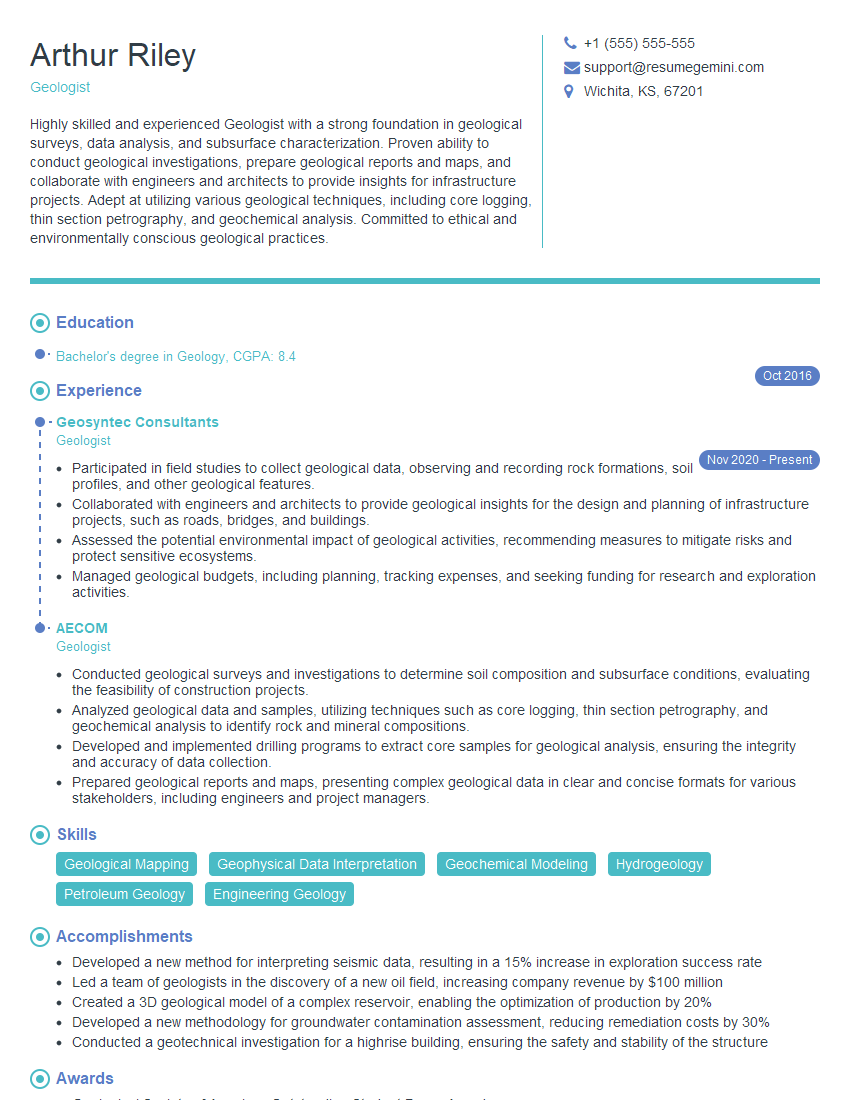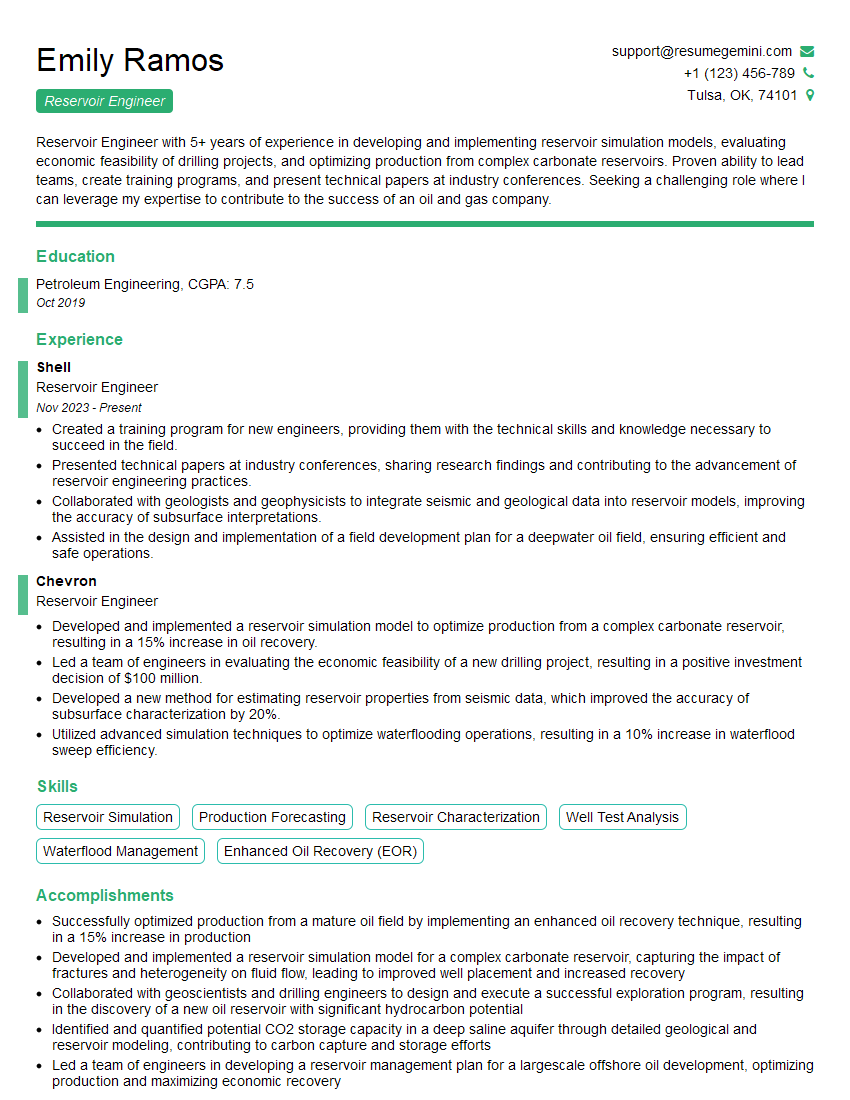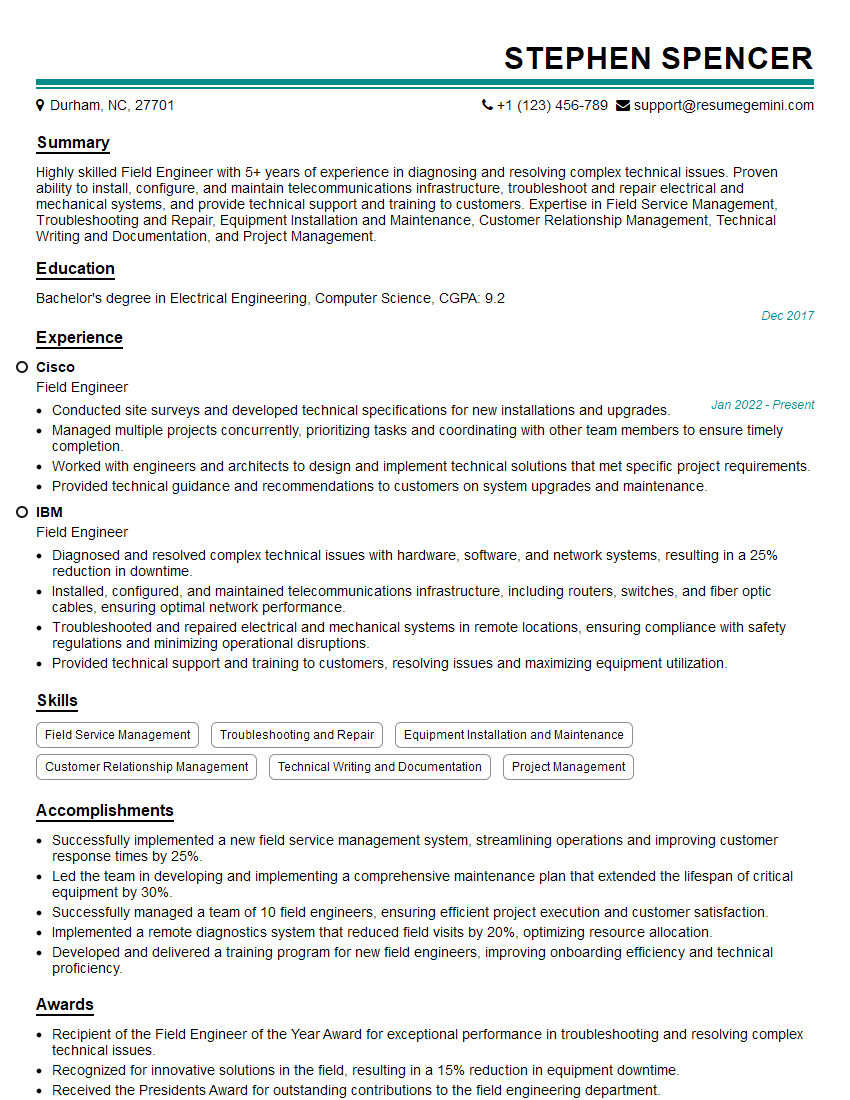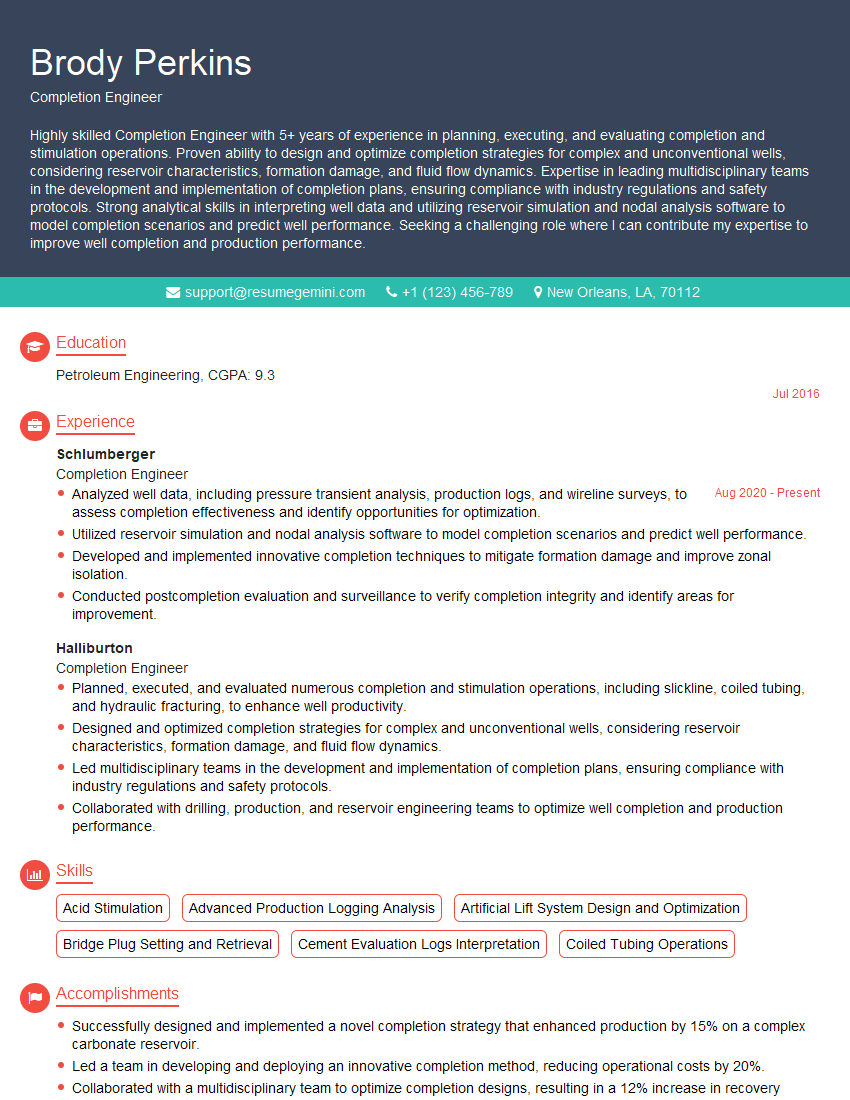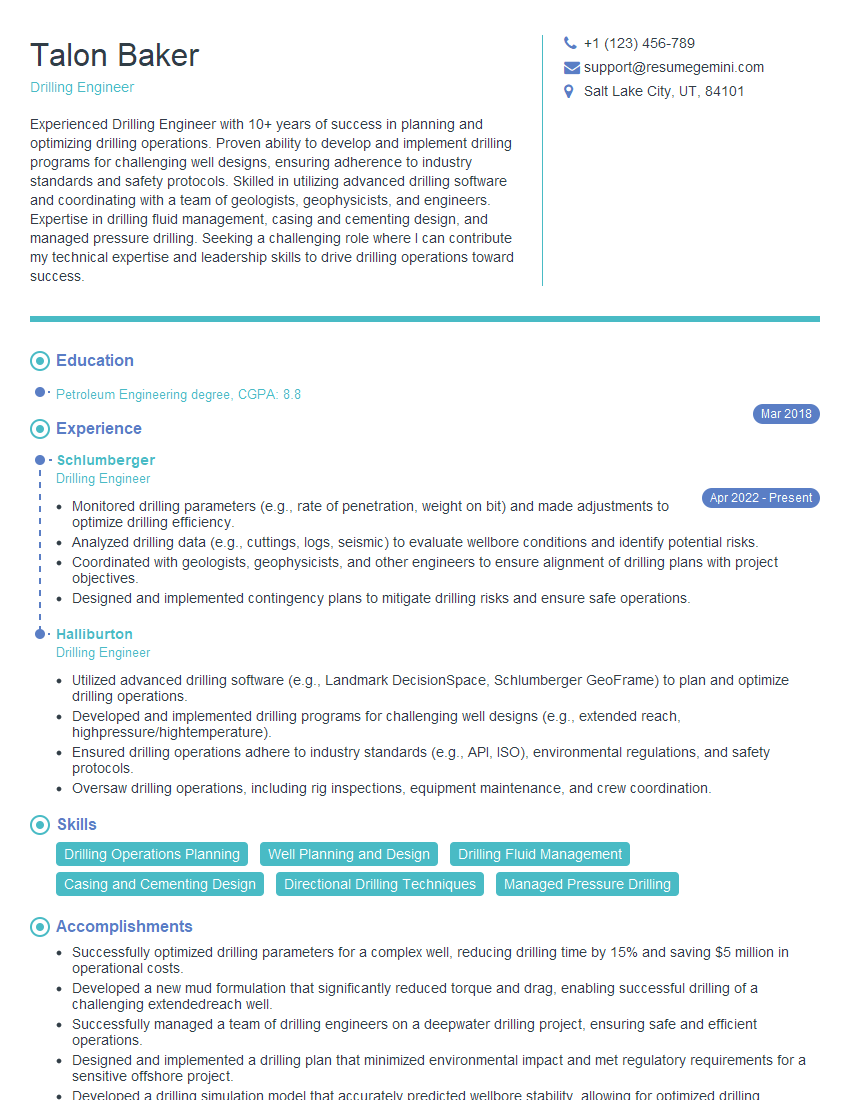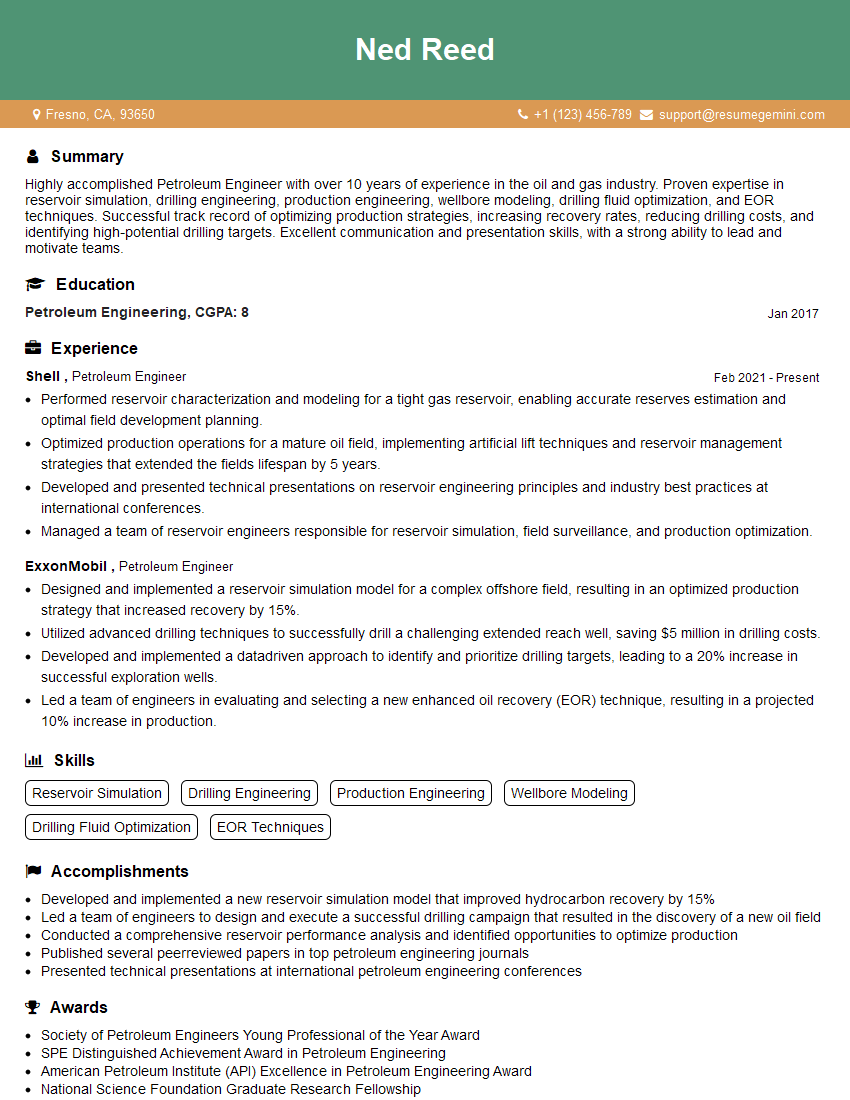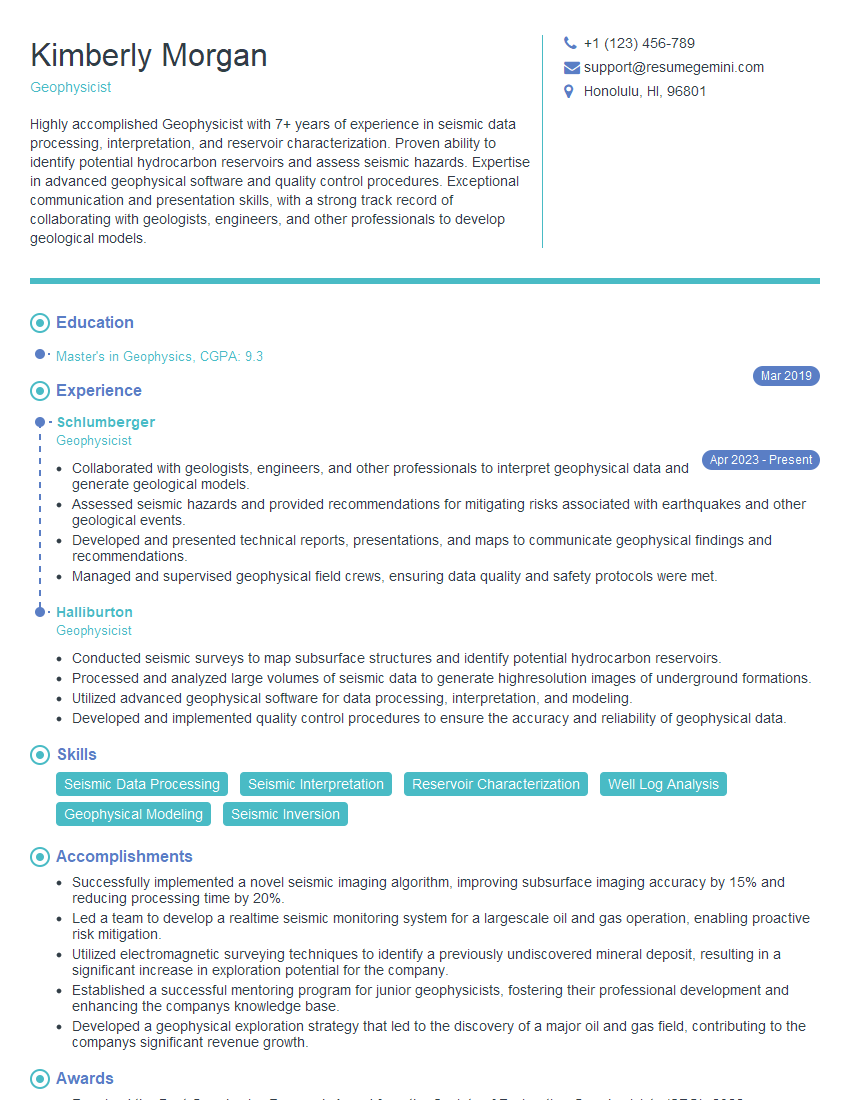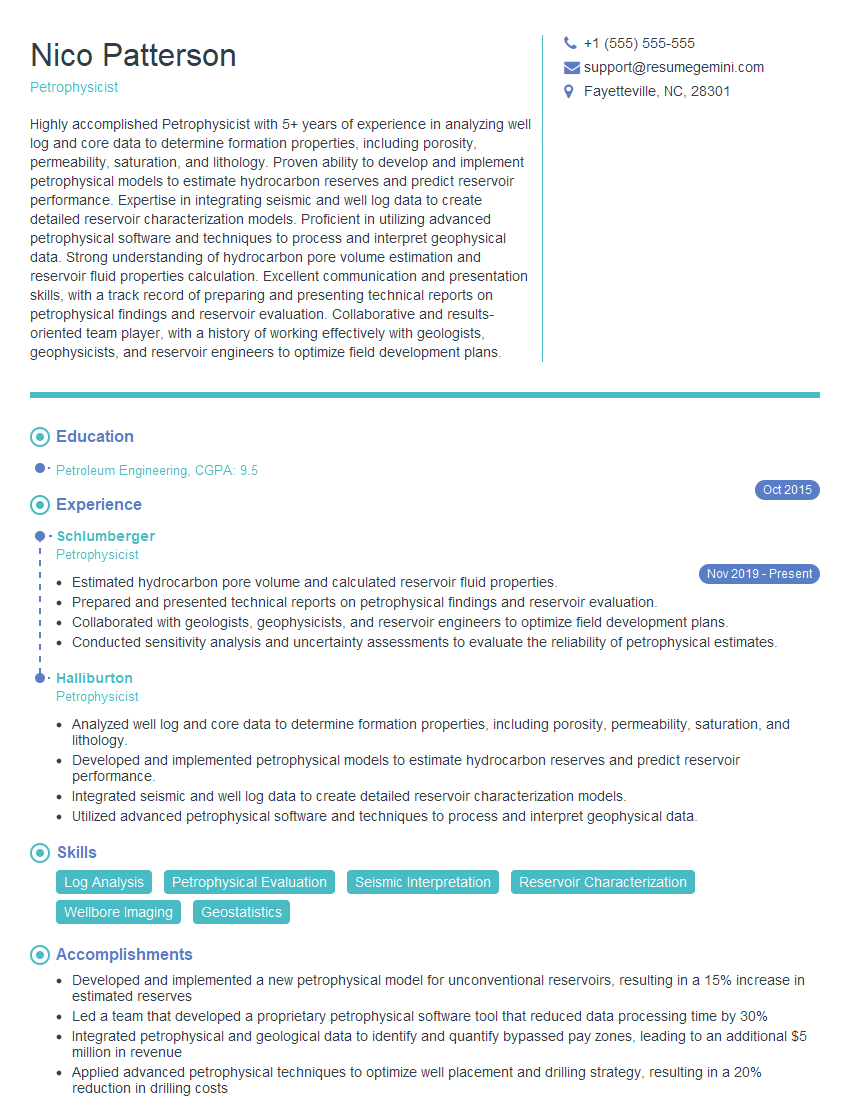Preparation is the key to success in any interview. In this post, we’ll explore crucial Reservoir Pressure Prediction interview questions and equip you with strategies to craft impactful answers. Whether you’re a beginner or a pro, these tips will elevate your preparation.
Questions Asked in Reservoir Pressure Prediction Interview
Q 1. Explain the concept of reservoir pressure depletion.
Reservoir pressure depletion is the gradual decrease in pressure within a hydrocarbon reservoir as fluids (oil, gas, and water) are produced. Imagine a balloon – initially full of air (hydrocarbons), as you release the air (production), the balloon shrinks (pressure decreases). This pressure drop is a fundamental aspect of reservoir engineering, impacting production rates and ultimately the economic viability of the field.
Several factors contribute to depletion. The primary driver is the withdrawal of fluids, leading to a reduction in reservoir pore pressure. This is exacerbated by the expansion of the remaining fluids as pressure decreases and by the compaction of the reservoir rock itself, which further reduces the pore space. The rate of depletion depends on factors such as the reservoir’s size, permeability, fluid properties, and the production rate.
Understanding pressure depletion is crucial for optimizing production strategies. Accurate prediction of pressure decline allows for the planning of well completions, artificial lift methods, and water injection schemes to maintain reservoir pressure and improve recovery efficiency. A rapid pressure decline can lead to reduced production rates and increased operating costs.
Q 2. Describe different methods for predicting reservoir pressure.
Predicting reservoir pressure involves a combination of techniques, each with its own strengths and limitations. The choice of method depends on the availability of data, the reservoir’s characteristics, and the desired accuracy.
- Material Balance Calculations: These are based on the fundamental principle of mass conservation. They require estimates of reservoir volume, initial fluid properties, and production history. Simple but often inaccurate due to simplifying assumptions.
- Numerical Simulation: This sophisticated method uses complex computer models to simulate fluid flow and pressure changes within the reservoir. It incorporates reservoir geometry, rock and fluid properties, and production scenarios. More accurate than material balance but computationally intensive and requires significant data input.
- Empirical Correlations: These are simplified formulas derived from historical data and statistical analysis. They are easy to apply but only work well for reservoirs similar to those used in developing the correlation. Their accuracy is often limited.
- Pressure Transient Analysis (PTA): This technique involves analyzing pressure changes in the wellbore during production (drawdown) or after shut-in (buildup). It provides insights into reservoir properties like permeability, skin factor, and reservoir boundaries. PTA is particularly useful for early-stage reservoir evaluation.
Q 3. What are the limitations of using material balance calculations for pressure prediction?
Material balance calculations, while conceptually straightforward, have significant limitations in accurately predicting reservoir pressure. The accuracy depends heavily on the assumptions made, which often deviate from reality. Key limitations include:
- Reservoir Homogeneity Assumption: Material balance typically assumes a uniform reservoir. Real reservoirs are heterogeneous, with variations in permeability, porosity, and fluid saturation. These variations significantly impact pressure distribution and cannot be captured adequately by simple material balance.
- Constant Reservoir Properties: The method often assumes constant reservoir properties (e.g., porosity, compressibility) over time. However, these properties can change due to compaction, fluid expansion, and other processes.
- Water Influx and/or Gas Cap Neglect: Accurate prediction requires considering water influx from aquifers and gas cap expansion, factors which significantly affect pressure behavior. Material balance often simplifies or neglects these influences.
- Accurate Data Requirement: It necessitates precise measurements of initial reservoir fluid volume and properties which can be difficult to obtain in practice.
These limitations mean that material balance calculations are often best used as a first-order approximation, followed by more sophisticated techniques for refinement.
Q 4. How does reservoir heterogeneity affect pressure prediction?
Reservoir heterogeneity, the variation in rock and fluid properties within a reservoir, significantly complicates pressure prediction. Imagine trying to predict the water level in a container with uneven walls and varying permeability – it’s far more challenging than a uniform container. Heterogeneity impacts pressure prediction in several ways:
- Uneven Pressure Distribution: In heterogeneous reservoirs, pressure does not decline uniformly. High-permeability zones deplete more quickly than low-permeability zones, leading to complex pressure gradients.
- Difficulty in Defining Average Properties: Determining representative values for porosity, permeability, and other properties is difficult when properties vary spatially. This affects the accuracy of all prediction methods.
- Increased Uncertainty in Simulation Results: Numerical simulation requires detailed characterization of heterogeneity. The lack of data or inaccurate characterization introduces uncertainty into model predictions.
- Impact on Production Strategy: Heterogeneity dictates optimal well placement and production strategies. Understanding its impact is critical for maximizing recovery.
Advanced reservoir characterization techniques, such as seismic imaging and well logging, are essential to mitigate the impact of heterogeneity on pressure prediction. Numerical simulation with detailed geological models is often required for accurate forecasting in heterogeneous reservoirs.
Q 5. Explain the principle of superposition in pressure transient analysis.
The principle of superposition in pressure transient analysis states that the pressure response at a given point in the reservoir due to multiple sources (e.g., wells) can be determined by summing up the individual pressure responses from each source as if they acted independently. This is a significant simplification, assuming linear reservoir behavior (i.e., pressure changes are directly proportional to the fluid flow rates).
Imagine dropping two pebbles into a still pond. Each pebble creates its own set of expanding circular waves. Superposition dictates that the final wave pattern is the sum of the individual wave patterns, even though the waves interfere with one another. Similarly, in a reservoir, the pressure response caused by multiple wells is the sum of individual well pressure responses.
This principle is crucial in analyzing multi-well systems. By understanding the individual pressure responses and applying superposition, we can predict the overall pressure distribution in a reservoir and optimize production strategies.
Q 6. Describe the different types of well tests used for pressure prediction.
Various well tests are employed to gather pressure data for reservoir characterization and pressure prediction. These tests induce transient pressure changes in the reservoir that are carefully analyzed to extract information.
- Drawdown Tests: The well is produced at a constant rate, and the pressure decline is measured over time. This provides information about reservoir permeability, skin effect, and possible boundaries.
- Buildup Tests: After a period of production, the well is shut in, and the pressure recovery is monitored. Buildup tests provide similar information as drawdown tests, but they often yield more reliable results because pressure changes are usually smaller and less affected by wellbore storage.
- Multiple Rate Tests: These involve changing the production rate during a test to enhance the sensitivity of the pressure response to various reservoir properties.
- Pulse Tests: Short periods of production or injection are followed by shut-in. These tests are often used in low-permeability reservoirs to obtain information more quickly.
- Interference Tests: Pressure changes in an observation well are monitored while another well is produced or injected. This provides information on reservoir connectivity and inter-well pressure communication.
The choice of well test depends on the specific objectives, reservoir characteristics, and operational constraints.
Q 7. How do you interpret pressure buildup and drawdown tests?
Interpreting pressure buildup and drawdown tests involves analyzing the pressure versus time data to extract reservoir properties. This typically involves plotting the data on specialized graphs (e.g., Horner plot for buildup tests, and various derivative plots for both drawdown and buildup) and analyzing the shape of the curves.
Drawdown Test Interpretation: Early-time data is influenced by wellbore storage and skin effect (resistance near the wellbore). Later-time data reveals information about reservoir properties such as permeability and the presence of reservoir boundaries. Analysis often involves fitting theoretical models to the data to estimate these parameters.
Buildup Test Interpretation: Buildup tests provide similar information as drawdown tests but often with better accuracy due to the smaller pressure changes involved. The Horner plot is commonly used to extrapolate the pressure data to infinite time, providing an estimate of the initial reservoir pressure. The slope of the plot is related to reservoir permeability.
Advanced analysis techniques such as type-curve matching and derivative analysis are frequently used to interpret complex pressure transient data and account for factors such as wellbore storage, skin, and reservoir boundaries. The interpretation often requires specialized software and expertise.
Q 8. Explain the concept of skin effect and its impact on pressure prediction.
The skin effect refers to the additional pressure drop experienced around a wellbore due to damage or stimulation. Imagine a straw in a drink – if the straw is partially clogged (damage), it takes more effort (pressure) to suck the liquid (oil/gas). Conversely, if the straw is widened (stimulation), it’s easier. This extra pressure drop, positive or negative, is quantified by the ‘skin factor’ (s), a dimensionless parameter. A positive skin indicates damage (increased pressure drop), while a negative skin indicates stimulation (decreased pressure drop). In pressure prediction, the skin effect significantly impacts the well’s productivity and pressure behavior. Ignoring it leads to inaccurate predictions of reservoir pressure and well performance. For instance, a well with a positive skin factor will exhibit lower pressure readings than predicted by models ignoring this effect.
Accurate pressure prediction requires estimating the skin factor, often through well test analysis (e.g., drawdown tests). The calculated skin factor is then incorporated into reservoir simulation models and analytical equations to correct for this localized pressure drop. This ensures a more accurate prediction of reservoir pressure and well productivity.
Q 9. What is the role of reservoir simulation in pressure prediction?
Reservoir simulation plays a crucial role in pressure prediction by providing a comprehensive, numerical representation of the reservoir’s behavior over time. Unlike simpler analytical methods that rely on several simplifying assumptions, reservoir simulation models incorporate complex geological details, fluid properties, and operational strategies. This allows for a much more realistic prediction of pressure changes in response to production or injection scenarios. It acts as a virtual laboratory, enabling engineers to test different operating strategies and scenarios without the cost and risk of real-world experiments.
For example, a reservoir simulator can predict the pressure decline in a reservoir under different production rates, allowing operators to optimize production strategies for maximum recovery while managing pressure depletion and potential reservoir damage.
Q 10. Describe different reservoir simulation techniques.
Reservoir simulation employs various techniques, broadly categorized into:
- Black Oil Simulators: These are relatively simple models, suitable for oil reservoirs with limited gas solubility and volatile components. They are computationally efficient but may lack the accuracy needed for complex reservoirs.
- Compositional Simulators: These models are more sophisticated and account for the complex phase behavior of hydrocarbons, including the interaction of various components (e.g., methane, ethane, propane). They provide more accurate results for reservoirs containing volatile oils or gas condensates but require more computational power.
- Thermal Simulators: These models incorporate the effect of heat transfer on fluid properties and flow behavior. They are crucial for modeling steam injection or other thermal recovery processes, which significantly affect reservoir pressure and fluid properties.
- Chemical Flooding Simulators: These simulations are specifically designed for enhanced oil recovery (EOR) processes involving chemical injection (e.g., polymer flooding, surfactant flooding), which alter the fluid properties and flow behavior within the reservoir.
The choice of simulation technique depends on the reservoir’s complexity, the required accuracy, and available computational resources. For instance, a simple black oil model might suffice for a mature, homogenous oil reservoir, while a compositional or thermal simulator is required for a complex reservoir undergoing steam injection.
Q 11. What are the key input parameters for a reservoir simulator?
Key input parameters for a reservoir simulator are diverse and often interdependent, falling into several categories:
- Geological Data: Reservoir geometry (shape, dimensions), rock properties (permeability, porosity, and their distributions), fault maps.
- Fluid Properties: Oil, gas, and water compositions and properties (density, viscosity, compressibility) – often derived from laboratory measurements.
- Initial Reservoir Conditions: Pressure, temperature, and saturation distributions throughout the reservoir.
- Production/Injection Data: Well locations, production rates, injection rates, and wellbore conditions (e.g., tubing diameter, skin factor).
- Numerical Parameters: Grid size, simulation time step, and numerical solution methods. These affect the computational cost and accuracy of the simulation.
The accuracy of the simulation heavily relies on the quality and completeness of these input parameters. Any uncertainties in these inputs will propagate through the simulation, affecting the prediction accuracy. For instance, an inaccurate permeability distribution can lead to significant errors in predicted pressure.
Q 12. How do you validate a reservoir simulation model?
Validating a reservoir simulation model is crucial to ensure its reliability. It involves comparing the simulation’s predictions with historical data and assessing the model’s ability to reproduce observed reservoir behavior. This typically involves:
- History Matching: Tuning the input parameters of the reservoir model to match historical production data (pressure, oil rate, water rate). This iterative process aims to achieve a reasonable match between simulated and observed data.
- Comparison with Well Tests: Comparing pressure predictions from the simulation with results from well tests (e.g., pressure buildup tests, drawdown tests). These tests provide valuable independent data to assess the accuracy of the model.
- Sensitivity Analysis: Evaluating the impact of uncertainties in input parameters on simulation results. This helps identify which parameters are most critical and need more accurate characterization.
A successful validation process demonstrates the model’s ability to accurately represent the reservoir’s past behavior, increasing confidence in its predictive capabilities for future scenarios. For example, if the simulation accurately predicts historical pressure declines under different production rates, we can be more confident in using it to predict future pressure trends.
Q 13. How do you account for uncertainty in reservoir pressure prediction?
Uncertainty in reservoir pressure prediction arises from various sources, including incomplete geological data, inaccuracies in fluid property measurements, and uncertainties in future operating conditions. Managing these uncertainties is crucial for making reliable decisions. Several approaches are used:
- Probabilistic Simulation: Instead of using single values for input parameters, probability distributions are assigned to reflect the uncertainty range. The simulation is then run many times with different parameter combinations drawn from these distributions, yielding a range of possible pressure predictions.
- Sensitivity Analysis: Identifying which input parameters have the largest impact on the pressure predictions. This helps focus efforts on reducing uncertainty in the most critical parameters.
- Ensemble Methods: Integrating multiple reservoir models, each with different parameterizations, to generate a range of possible outcomes. This approach accounts for uncertainties arising from different model assumptions and data interpretations.
By quantifying and propagating uncertainties throughout the prediction process, we can obtain a more realistic assessment of the likely range of future reservoir pressures and make informed decisions considering the associated risks.
Q 14. What are the common challenges in reservoir pressure prediction?
Several challenges hinder accurate reservoir pressure prediction:
- Data Scarcity and Uncertainty: Limited subsurface data (especially in early exploration stages) can lead to significant uncertainty in reservoir characterization. Poor data quality also affects the reliability of input parameters.
- Reservoir Heterogeneity: Reservoirs are rarely uniform; variations in permeability, porosity, and other properties create complex flow patterns, making accurate simulation challenging.
- Complex Fluid Behavior: Non-ideal fluid behavior, such as phase transitions and compositional changes, add complexity to simulations and prediction accuracy.
- Computational Limitations: Simulating large, complex reservoirs requires significant computational resources, and this can restrict the use of more advanced simulation techniques.
- Uncertain Future Operating Conditions: Production rates, injection strategies, and other operating parameters may change over time, introducing uncertainties into long-term pressure predictions.
Addressing these challenges requires integrated approaches, including improved data acquisition techniques, advanced reservoir characterization methods, sophisticated simulation models, and robust uncertainty quantification techniques.
Q 15. Explain the concept of water coning and its impact on pressure.
Water coning is a phenomenon where the water in an underlying aquifer rises towards a producing well, creating a cone-shaped interface between water and oil (or gas). This happens because the pressure in the wellbore is reduced during production, causing a pressure gradient that draws the water upwards. The impact on pressure is twofold:
- Reduced Reservoir Pressure: The influx of water dilutes the oil (or gas) production and can significantly reduce the reservoir pressure faster than expected in predictions. This is because water is less compressible than hydrocarbons, meaning the overall pressure drop is not solely dependent on the hydrocarbon withdrawal.
- Early Water Breakthrough: In extreme cases, water coning can lead to early water breakthrough, where water enters the wellbore prematurely, reducing the economic viability of the well and potentially causing operational challenges.
Imagine a drinking straw in a glass of water with oil floating on top. If you suck on the straw, the water will rise towards the straw, mimicking the water coning effect in a reservoir. The faster you suck (higher production rate), the faster the water level will rise.
Career Expert Tips:
- Ace those interviews! Prepare effectively by reviewing the Top 50 Most Common Interview Questions on ResumeGemini.
- Navigate your job search with confidence! Explore a wide range of Career Tips on ResumeGemini. Learn about common challenges and recommendations to overcome them.
- Craft the perfect resume! Master the Art of Resume Writing with ResumeGemini’s guide. Showcase your unique qualifications and achievements effectively.
- Don’t miss out on holiday savings! Build your dream resume with ResumeGemini’s ATS optimized templates.
Q 16. Describe how you would handle a situation where predicted pressure deviates significantly from measured pressure.
Significant deviations between predicted and measured pressure necessitate a systematic investigation. The process involves several steps:
- Verify Data Quality: The first step is to rigorously check the accuracy and reliability of both predicted and measured pressure data. This includes validating well test data, reviewing pressure gauge calibrations, and ensuring proper data acquisition procedures were followed.
- Review Model Assumptions: Next, examine the assumptions made during the reservoir model construction. Are the reservoir fluid properties accurate? Is the reservoir geometry correctly represented? Have we adequately accounted for faults, fractures, or other geological heterogeneities? Perhaps the initial reservoir pressure or permeability values need refinement. A common oversight is neglecting capillary pressure effects.
- Assess Model Calibration: The accuracy of the pressure prediction relies heavily on the model’s calibration. If the model is poorly calibrated, it won’t accurately reflect reality. We might need to re-calibrate the model using additional well test data or production history matching techniques.
- Consider External Factors: Factors external to the reservoir itself, such as changes in the production strategy or unexpected geological events (e.g., induced seismicity), can influence pressure. We must investigate any such occurrences.
- Model Refinement or Reconstruction: Based on the findings from the previous steps, the reservoir model may require refinement, or in extreme cases, complete reconstruction. This could involve incorporating additional data, improving the grid resolution, updating the geological interpretation, or using a more sophisticated numerical simulator.
Addressing these points will significantly improve the accuracy of the reservoir model and reduce discrepancies between prediction and measurement. It’s a systematic approach of problem-solving. For example, if the deviation is consistent across multiple wells, a global model parameter adjustment might be necessary, whereas local deviations often point towards issues with individual wells or localized geological features.
Q 17. How does the presence of gas affect reservoir pressure prediction?
The presence of gas significantly complicates reservoir pressure prediction due to its compressibility and its potential to expand or dissolve into other phases. Several key aspects must be considered:
- Gas Compressibility: Gas is highly compressible, meaning its volume changes dramatically with pressure. This effect dominates the pressure behavior of a gas reservoir and influences its depletion rate. This means a simple material balance approach might not be sufficient; we’d need to employ more sophisticated techniques that account for non-ideal gas behavior.
- Gas Solubility: Gas can dissolve into oil, altering its properties (density, viscosity) and affecting its volume. This is especially important in undersaturated oil reservoirs. Changes in pressure influence the amount of dissolved gas, significantly affecting reservoir pressure prediction.
- Two-Phase or Three-Phase Flow: The presence of gas can lead to two-phase (oil and gas) or even three-phase (oil, gas, water) flow, requiring complex fluid flow models within the reservoir simulation.
Accurate reservoir pressure prediction in the presence of gas requires sophisticated reservoir simulation software that uses an equation of state to model the phase behavior and compressibility of the reservoir fluids. Ignoring these gas effects often leads to inaccurate predictions.
Q 18. What is the impact of temperature on reservoir pressure?
Temperature significantly impacts reservoir pressure prediction primarily through its effect on fluid properties. As temperature increases:
- Fluid Density Decreases: Higher temperatures lead to lower fluid densities, resulting in a decrease in the hydrostatic pressure gradient. This effect is more pronounced in gas reservoirs.
- Fluid Viscosity Decreases: Reduced viscosity increases fluid mobility, influencing flow patterns and production rates. This indirectly affects pressure depletion.
- Formation Compressibility Changes (Slightly): While less significant than the effects on fluid properties, temperature changes can cause minor alterations in rock compressibility. Usually this effect is considered secondary.
In practice, temperature gradients are usually incorporated into the reservoir model, particularly when dealing with deep reservoirs or reservoirs with significant temperature variations. Accurate temperature profiles are crucial for precise pressure predictions, especially in geothermal applications or deep-water settings where temperature changes can be substantial.
Q 19. Explain the concept of formation compressibility and its relevance to pressure prediction.
Formation compressibility represents the rock’s ability to change volume in response to pressure changes. It’s a crucial parameter in reservoir pressure prediction because it quantifies the rock’s contribution to pressure variations.
Mathematically, formation compressibility (cf) is defined as the fractional change in rock volume per unit change in pressure:
cf = - (1/V) (dV/dP)
where V is the rock volume and P is the reservoir pressure.
In reservoir simulation, formation compressibility is integrated into the governing equations to calculate changes in pore volume and consequently, pressure. A higher formation compressibility means the rock matrix is more compliant, leading to larger pore volume changes for a given pressure change. This, in turn, influences the overall pressure decline rate in the reservoir. For example, in unconsolidated sandstone reservoirs, the formation compressibility is often higher than in more consolidated formations, leading to faster pressure depletion.
Q 20. How do you account for changes in reservoir fluid properties during pressure prediction?
Changes in reservoir fluid properties significantly affect pressure prediction, requiring sophisticated modeling techniques. These changes are primarily caused by pressure depletion and temperature variations.
- Equation of State (EOS): Modern reservoir simulation relies heavily on EOS to accurately predict fluid properties as a function of pressure, temperature, and composition. The EOS model allows to simulate multiphase equilibrium, phase changes, and fluid property variations during depletion.
- PVT Analysis: Pressure-Volume-Temperature (PVT) analysis is crucial for characterizing reservoir fluids and their behavior under different conditions. PVT laboratory experiments determine the fluid properties at various pressures and temperatures, providing the input data needed for the EOS model.
Ignoring fluid property changes during pressure prediction results in inaccurate and unreliable results. For example, if the reservoir contains volatile oil, failing to model the gas liberation as pressure decreases will lead to a significant overestimation of the pressure.
Q 21. Describe the difference between static and dynamic reservoir models.
Static and dynamic reservoir models represent different aspects of reservoir behavior and are used for different purposes.
- Static Reservoir Model: A static model represents the reservoir at a single point in time, capturing its geological properties (e.g., porosity, permeability, geometry, fluid saturation). This model is essentially a snapshot of the reservoir and doesn’t simulate fluid flow. It’s primarily used for initial reservoir characterization, volume calculations, and generating inputs for the dynamic model.
- Dynamic Reservoir Model: A dynamic model simulates fluid flow and pressure changes within the reservoir over time. This model incorporates data from the static model and considers production history, well configurations, fluid properties, and various reservoir mechanisms. The dynamic model is used to predict future reservoir performance, optimize production strategies, and forecast pressure changes.
Think of a static model as a photograph of a reservoir at a specific moment, while a dynamic model is a movie that shows how the reservoir changes over time. Both are essential tools used in conjunction for comprehensive reservoir management.
Q 22. What are the advantages and disadvantages of using empirical correlations for pressure prediction?
Empirical correlations offer a quick and relatively inexpensive way to estimate reservoir pressure, particularly in early exploration stages when data is limited. They are essentially simplified mathematical relationships derived from historical data and theoretical understanding of reservoir behavior. However, their accuracy is limited by the assumptions made during their development and their applicability to a specific reservoir. They might not accurately capture the complexities of a unique reservoir system.
- Advantages: Easy to use, require minimal data, computationally inexpensive, provide a first-order estimate.
- Disadvantages: Limited accuracy, highly dependent on the similarity between the correlating reservoir and the target reservoir, might not account for complex geological features or fluid properties, potentially inaccurate in highly heterogeneous reservoirs.
For example, a simple correlation might relate pressure to depth and reservoir properties like porosity and permeability. While this can provide a starting point, it won’t account for factors like water influx or production history which significantly impact pressure.
Q 23. Explain the concept of pressure support mechanisms in reservoirs.
Pressure support mechanisms in reservoirs describe the processes that maintain reservoir pressure over time, counteracting the pressure drop caused by fluid withdrawal. Understanding these mechanisms is crucial for accurate pressure prediction and production management. Several key mechanisms exist:
- Water influx: Water from aquifers surrounding the reservoir flows into the reservoir, compensating for the produced fluids.
- Gas cap expansion: In reservoirs with a gas cap, the expansion of the gas as fluids are produced helps maintain pressure.
- Rock compressibility: The reservoir rock itself compresses slightly, releasing some of the stored energy and counteracting pressure depletion.
- Fluid expansion: As fluids are produced, the remaining fluids expand slightly to fill the available space.
Think of it like a water balloon: If you start draining the water (producing fluids), the balloon (reservoir) will shrink (pressure drops). But, if you have a water source connected (aquifer influx), the balloon maintains its size (pressure) better. The relative contribution of each mechanism depends on the specific reservoir characteristics.
Q 24. How does reservoir pressure prediction influence production optimization?
Reservoir pressure prediction is absolutely fundamental to production optimization. Accurate pressure forecasts allow us to:
- Optimize production rates: Knowing future pressure decline helps determine sustainable production rates to maximize hydrocarbon recovery while minimizing pressure drops that could damage the reservoir.
- Design efficient well completions: Predicting pressure allows engineers to optimize well locations and completion strategies to maximize productivity.
- Plan enhanced oil recovery (EOR) operations: Pressure forecasts are crucial for determining when and where EOR methods like waterflooding or gas injection should be implemented.
- Estimate reserves: Pressure decline analysis is integrated with other data to estimate the remaining reserves in a reservoir.
- Manage artificial lift systems: Pressure forecasts allow for optimized selection and scheduling of artificial lift systems like pumps or gas lift to maintain desired production rates.
Without accurate pressure prediction, production decisions might lead to premature reservoir depletion or inefficient use of resources.
Q 25. Describe your experience with different reservoir simulation software packages.
Throughout my career, I’ve gained extensive experience with several industry-standard reservoir simulation software packages. This includes CMG (Computer Modelling Group) software suite (specifically STARS and IMEX), Eclipse from Schlumberger, and Petrel from Schlumberger. I’m proficient in building and running reservoir simulation models, including history matching and forecasting pressure and production performance. My experience ranges from simpler black-oil simulations to complex compositional models, accounting for various fluid properties and geological heterogeneities. I am also comfortable with the pre-processing and post-processing workflows required for effective reservoir modeling.
For instance, I have used CMG STARS to model a complex carbonate reservoir with significant fracturing, requiring a detailed representation of the fracture network and its impact on fluid flow. In other projects, I’ve leveraged Eclipse’s capabilities for compositional simulation to accurately model gas injection projects.
Q 26. How do you ensure the accuracy and reliability of your pressure prediction results?
Ensuring the accuracy and reliability of pressure prediction results is paramount. This involves a multi-faceted approach:
- Rigorous data quality control: Thorough validation of input data (pressure, production, fluid properties, etc.) is essential to avoid errors propagating through the model.
- History matching: The model is calibrated against historical pressure and production data to ensure it accurately represents past reservoir behavior. This iterative process involves adjusting model parameters until the model’s output matches historical data.
- Sensitivity analysis: Investigating the sensitivity of predictions to input parameters helps quantify uncertainty and identify critical parameters requiring more precise estimation.
- Uncertainty quantification: Using techniques like Monte Carlo simulation to quantify the uncertainty associated with predictions, reflecting the inherent uncertainty in input parameters.
- Model validation: Comparing simulation results against independent data sources like pressure transient tests or interference tests to validate model accuracy.
This rigorous process aims to reduce uncertainties and build confidence in the predictive capabilities of the reservoir model.
Q 27. Explain the importance of data quality in reservoir pressure prediction.
Data quality is the cornerstone of accurate reservoir pressure prediction. Garbage in, garbage out – this principle is exceptionally true in reservoir modeling. Poor data quality can lead to significant errors in pressure forecasts and flawed production decisions. The importance extends to several aspects:
- Pressure data: Accurate and consistent bottomhole pressure measurements are crucial. Errors in pressure readings can lead to substantial misinterpretations of reservoir behavior.
- Production data: Complete and reliable production data (oil, gas, water rates) are necessary to build accurate history matches and understand the impact of production on pressure.
- Fluid properties: Accurate characterization of fluid properties (oil, gas, water) is critical because these properties significantly affect fluid flow and pressure behavior. Errors in these properties can lead to large errors in pressure predictions.
- Reservoir properties: Accurate reservoir properties (porosity, permeability, saturation) are crucial for a realistic simulation model. These properties need to be appropriately represented in the model to account for reservoir heterogeneity.
Data quality checks, including data validation, outlier detection, and data reconciliation, are essential steps in ensuring a reliable and accurate pressure prediction.
Q 28. Describe a situation where you had to troubleshoot a problem related to reservoir pressure prediction.
In one project involving a mature oil field, we experienced significant discrepancies between predicted and observed pressure declines. Initial simulations, using a simple black-oil model, consistently underestimated the pressure drop. After a thorough investigation, we discovered that the original reservoir model neglected the impact of significant water coning—where water from the lower parts of the reservoir flows into the producing well. Once we incorporated a more detailed representation of the reservoir heterogeneity and included a more sophisticated model of water coning, the discrepancies between the model and observations reduced significantly. This highlighted the importance of detailed geological modeling and careful consideration of all potential pressure support mechanisms. The solution involved refining the geological model, incorporating detailed water saturation data, and using a more advanced simulation technique to capture the complex fluid flow processes. This experience underscored the importance of iterative model building, thorough data analysis, and critical evaluation of assumptions during reservoir pressure prediction.
Key Topics to Learn for Reservoir Pressure Prediction Interview
- Material Balance Principles: Understanding the fundamental relationships between reservoir fluids, pressure, and volume. This forms the bedrock of most prediction methods.
- Reservoir Simulation Techniques: Familiarize yourself with numerical reservoir simulation, its applications in pressure prediction, and the limitations of different simulation approaches. Consider exploring both black-oil and compositional simulators.
- Pressure Transient Analysis (PTA): Mastering the interpretation of pressure buildup and drawdown tests to estimate reservoir properties and predict future pressure behavior. Practice analyzing type curves and solving for key parameters.
- Decline Curve Analysis (DCA): Learn to apply different decline curve models to forecast future production and pressure changes. Understand the assumptions and limitations of each model.
- Data Analysis and Interpretation: Develop strong skills in analyzing well test data, production data, and geological information to build accurate pressure prediction models. Proficiency in data visualization is crucial.
- Practical Applications: Understand how pressure prediction is used in reservoir management decisions, such as optimizing production strategies, well testing design, and enhanced oil recovery (EOR) techniques.
- Uncertainty and Risk Assessment: Learn how to quantify uncertainties in pressure predictions and incorporate them into decision-making processes. Explore probabilistic methods for risk assessment.
- Advanced Topics (for Senior Roles): Consider exploring advanced techniques like reservoir characterization, geostatistics, and integrated reservoir studies for a more comprehensive understanding.
Next Steps
Mastering reservoir pressure prediction is essential for career advancement in the petroleum industry, opening doors to senior roles and specialized projects. A strong understanding of these techniques demonstrates valuable analytical and problem-solving skills highly sought after by employers. To significantly improve your job prospects, focus on crafting an ATS-friendly resume that effectively highlights your skills and experience. We recommend using ResumeGemini, a trusted resource, to build a professional and impactful resume. ResumeGemini provides examples of resumes tailored specifically to Reservoir Pressure Prediction roles to help you create a compelling application.
Explore more articles
Users Rating of Our Blogs
Share Your Experience
We value your feedback! Please rate our content and share your thoughts (optional).
What Readers Say About Our Blog
Take a look at this stunning 2-bedroom apartment perfectly situated NYC’s coveted Hudson Yards!
https://bit.ly/Lovely2BedsApartmentHudsonYards
Live Rent Free!
https://bit.ly/LiveRentFREE
Interesting Article, I liked the depth of knowledge you’ve shared.
Helpful, thanks for sharing.
Hi, I represent a social media marketing agency and liked your blog
Hi, I represent an SEO company that specialises in getting you AI citations and higher rankings on Google. I’d like to offer you a 100% free SEO audit for your website. Would you be interested?
